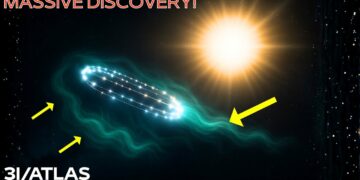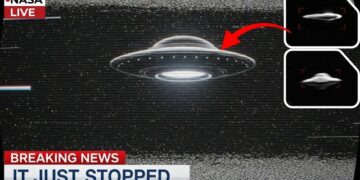The vastness of space holds mysteries and potential dangers, with objects and phenomena that keep NASA vigilant. From asteroids on collision courses to enigmatic cosmic events, these threats captivate and unsettle scientists. Here’s an exploration of the space objects and events that have NASA watching the skies.
Asteroid Bennu
Discovered on September 11, 1999, by the Lincoln Near-Earth Asteroid Research (LINEAR) team, Bennu (initially named 1999 RQ36) is a near-Earth asteroid. Radar imaging at Arecibo Observatory and Goldstone Deep Space Network in 1999 provided initial data. The OSIRIS-REx mission, launched in September 2016, reached Bennu in 2018, mapped its surface, and collected samples in October 2020. These samples returned to Earth in September 2023, with early findings shared on May 15, 2024.
Studies estimate an asteroid like Bennu (500 meters wide, or 1,600 feet) could strike Earth every 130,000 years. In 2010, Andrea Milani’s team calculated a 0.71% chance of Bennu impacting Earth between 2169 and 2199, with eight potential impact windows. Improved radar data from 1999, 2005, and 2011 refined predictions, adjusting the collision risk to 0.037% for 2175–2196, equivalent to a -1.71 score on the Palermo Scale. An impact could release 1,200 megatons of energy (TNT equivalent), far exceeding the Tsar Bomba (54 megatons) or the Tunguska event (3–30 megatons). The Yarkovsky effect, where solar heating causes tiny orbital shifts, complicates predictions, requiring detailed models of Bennu’s shape and properties.
Asteroid Apophis
Discovered on June 19, 2004, by Roy Tucker, David Tholen, and Fabrizio Bernardi at Kitt Peak National Observatory, Apophis raised concerns due to its close approach to Earth (9 million miles) in December 2004. Early data suggested a 20% chance of impact on April 13, 2036, but January 2013 radar observations from Goldstone reduced this to less than one in a million. By February 2013, the probability dropped to 7 in 1 billion. Simulations indicated the Yarkovsky effect could push Apophis through a gravitational “keyhole” in 2029, potentially leading to closer approaches in 2051 or 2068, though the odds remain low (2 in 1 million). March 2021 radar data confirmed Apophis poses no impact risk for at least 100 years. Despite this, Apophis remains a long-term hazard unless its orbit is altered by close encounters with Venus or Mars.
Other Near-Earth Asteroids
NASA monitors numerous near-Earth objects. In 2024, asteroids like 2024 XU9 (110 feet, airplane-sized), 2024 XB16 (47 feet, house-sized), 2024 XF4 (200 feet, airplane-sized), 2024 XY5 (71 feet), 2024 XB6 (56 feet), and 2024 RV50 (710 feet, stadium-sized) will pass Earth between October and December. While the risk of impact is low due to vast distances, NASA’s Jet Propulsion Laboratory continuously tracks these objects to assess potential threats.
Solar Flares
The Sun, vital for life, can unleash powerful solar flares—bursts of radiation and charged particles. These can disrupt Earth’s magnetic field, triggering geomagnetic storms that affect radio communications, GPS, air traffic control, satellites, and power grids. Severe storms could cause widespread blackouts. However, solar flares also create stunning auroras when charged particles interact with Earth’s atmosphere. Space weather forecasting is critical to mitigate these risks.
Rogue Planets
Rogue planets, or free-floating planetary-mass objects, drift through space without orbiting a star. Formed either by ejection from a solar system or independent gas cloud collapse, they may number in the billions or trillions in the Milky Way. Discovered in 2000 in the Orion Nebula and Sigma Orionis cluster, these planets could theoretically support life via thick hydrogen atmospheres or internal heat from radioactive decay. However, their lack of sunlight poses challenges. The odds of a rogue planet colliding with Earth are minuscule, but such an impact would trigger catastrophic earthquakes, tsunamis, and volcanic eruptions, potentially causing a “nuclear winter” by blocking sunlight.
Rogue Stars
Rogue stars, or hypervelocity stars, discovered in 1997 in the Virgo Galaxy Cluster, are ejected from galaxies due to collisions or interactions with supermassive black holes. Stars like HIP 85605 and Gliese 710 could disrupt our solar system if they approached, causing gravitational chaos, earthquakes, and volcanic activity. Their radiation could strip Earth’s atmosphere, rendering it uninhabitable. However, the vast distances between stars make such encounters rare—HIP 85605 will pass 8,000 astronomical units away in 240,000 years, and Gliese 710 may disturb the Oort Cloud in 1.29 million years.
Gamma-Ray Bursts (GRBs)
GRBs, the universe’s most energetic events, emit intense gamma rays for milliseconds to minutes, outshining the Sun’s 10-billion-year output. Discovered in 1967 by U.S. satellites monitoring nuclear tests, GRBs were identified as cosmic phenomena by 1973. Short GRBs (under 2 seconds) result from neutron star mergers, while long GRBs (over 2 seconds) follow massive star collapses. A nearby GRB could deplete Earth’s ozone layer, exposing life to lethal UV radiation, causing ecosystem collapse, and triggering a “GRB winter” with global cooling. DNA damage and mass extinctions could follow.
Black Holes
Black holes, regions where gravity traps even light, form from collapsing massive stars. Proposed in 1783 by John Michell and confirmed via Einstein’s relativity, they were evidenced in 1975 with Cygnus X-1. A stellar-mass black hole (10 solar masses) entering our solar system would disrupt planetary orbits, causing collisions or ejections, and trigger geological chaos. A supermassive black hole (millions to billions of solar masses) would devastate the solar system, with its accretion disk’s radiation sterilizing Earth.
Rogue Black Holes
Rogue black holes, detected in 2022 via Hubble and microlensing, wander without a host galaxy. A 7-solar-mass black hole, 5,000 light-years away, moves at 45 km/s. If one approached our solar system, its gravity would eject planets or cause collisions, while its radiation could strip Earth’s atmosphere. A galactic core encounter could disrupt the Milky Way’s structure. However, the vastness of space makes such events exceedingly rare.
Comets
Comets, icy bodies that release gases near the Sun, form comas and tails. Ranging from hundreds of meters to tens of kilometers, they’ve been observed since ancient times. Comets may have delivered water to Earth 4 billion years ago, with organic molecules like amino acids potentially seeding life. In 2013, comet impacts were linked to protein formation. While over 4,000 comets are known, the outer solar system may hold a trillion. Probes like NASA’s Deep Impact and ESA’s Rosetta have studied comets, but their random orbits make them harder to predict than asteroids. No major comet impacts have occurred in recorded history, but the potential remains.
Supernovae
Supernovae, explosive stellar deaths, outshine galaxies briefly. Type I supernovae occur in binary systems when a white dwarf reaches critical mass, while Type II result from massive stars (8+ solar masses) collapsing. Observed since 185 AD, their nature was clarified in 1934 by Baade and Zwicky. SN 1987A provided key insights. A nearby supernova’s radiation would strip Earth’s ozone layer, causing UV damage, ecosystem collapse, and health crises. Its shockwave could disrupt planetary orbits and trigger star formation. The risk is low due to the rarity of nearby massive stars.
Conclusion
NASA’s vigilance over asteroids, solar flares, rogue planets, stars, black holes, comets, and supernovae reflects the need to understand and mitigate cosmic threats. While the probability of catastrophic impacts remains low, the consequences of such events—ranging from ecosystem disruption to global extinction—underscore the importance of continued monitoring and research into the mysteries of space.























